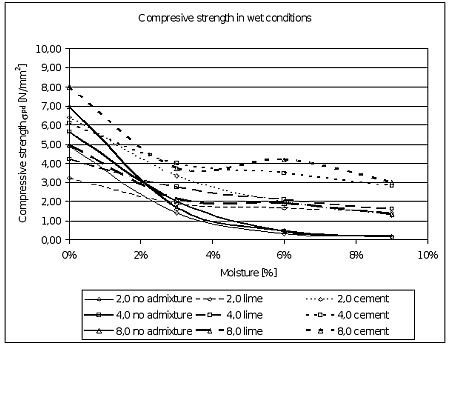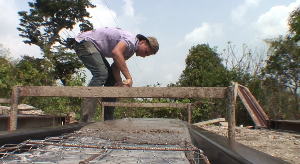Compressed earth blocks... resisting moisture ?

Jan Ruzicka has done interesting studies at the Czech Technical University in Prague that shed some light on this decisive question: Does the admixture of cement or lime actually improve the earth blocks when they are humid?
Many investigations exist
about the performance of CEBs (compressed earth blocks) under
laboratory conditions. However, they usually do not consider the
impact of moisture, and after all that is the decisive point. It is
obvious that even “natural adobe bricks” (handmoulded, sun dried)
will perform perfectly well in a dry state. The compressive strength
of an average natural adobe by far exceeds the requirements for a one
or two- or even a three-storey building.
You can download the full document following this link
However, it is not the compressive strength of the bricks that determines the resistance to earthquakes, but the shearing strength of the wall, and this is where natural adobe bricks actually have an advantage over CEBs . Adobes generally have better adherence to the mortar due to their rough surface, while CEBs invariably have very smooth surfaces and there is little mechanical bond with the mortar. In an un-reinforced building a thick adobe wall will be more resistant to earthquakes than a more slender wall made of CEB’s, even though they have much higher compressive strength. That is why buildings made of CEBs should be combined with a suitable frame (usually reinforced concrete posts and beams) in areas with a high earthquake risk.
However, what happens when the wall is moist? Earthquakes often occur when it rains…..in many places average humidity is high and walls always have a degree of moisture, mainly close to the ground where shearing forces are highest. After all, the only real shortcoming of natural adobes (in technical terms) is their resistance to moisture.
Is
the compression more important than the admixture ?
When Jan began his
PhD studies on CEBs he asked himself whether it was the admixture of
cement or lime that made the bricks strong, or whether it really was
the compression. And the results were most interesting : When low
pressure (2,0 MPa - which is similar to hand
made ramming of earthen blocks) was applied in the production
of the blocks, the admixture of 5% cement or lime does improve the
compressive strength of the bricks. However, when the pressure in the
block making was doubled to 4 Mpa, the difference became smaller, and
when producing the blocks with 8Mpa (aprox 80 Kg per cm2) the blocks
without admixture actually caught up with the cement admixed and left
the lime admixed behind!
That gives a totally new perspective: Is the money spent on cement a waste? Should one instead invest in higher compression? About the same time, Belkis Saroza in Cuba had come to very similar results; she also claimed that compression was more important than admixture.
But there is this other extremely important question: what happens when the blocks are moist ?
Behavior of moist
blocks
Another series of tests
with 150 blocks was started, again with the same scientific rigor,
using exactly the same materials and the same procedure. The cured
blocks were then divided into three different lots and subjected to
moisture impregnation at the level of 3%, 6% and 9% by weight.
The moist samples were tested and now the Portland cement admixture was able to prove its own.
At 3% moisture the samples without admixture already lost most of their compressive strength; however they still are at levels around 2 Mpa which is more than sufficient for load bearing walls in one- and two-storey buildings. The cement added samples also lost half their strength, but preserved some 4 Mpa. Interestingly, the lime added samples suffered less.
At 6% moisture the samples without admixture had fallen to 0.5 Mpa, still enough to hold up a wall in one- and two-storey buildings and definitely good enough for infill in a reinforced cement structure (which is where most of the CEBs are used). Lime and cement added blocks remained at the same level.
At 9% moisture the samples without admixture had lost most of their compressive strength and could not be considered structurally, while lime added blocks still tested at 1.5 Mpa and cement added ones at 3 Mpa.
The same test procedure was also followed for bending strength and the results were similar, however more accentuated. At 9% moisture the samples without admixture could not be tested anymore, as they were too weak.


Conclusions
Under high moisture
conditions the addition of cement or lime to CEBs does improve their
performance significantly. In other words, where the CEBs are
subjected to a high risk of moisture it is advisable to mix cement or
lime (5% in those tests) into the mix. The compression in the
fabrication of CEBs is not as important as perceived at the
beginning, as when they are moist the differences are small.
However, I consider it would be most interesting to know how much moisture a wall has to live with? What is the level of moisture inside a brick wall at different heights of the wall. Of course, this would have to be done in relation to the average humidity of the environment, influences of winds and exposure to the sun…..Ideas for another investigation.
Important
notice
A very important
question is how to choose the most suitable admixture. Every time it
depends on mineralogical composition and grain-size distribution of
used soil! Generally it is recommended to use cement with sandy soil
and lime with clay or loamy-clay soil. But the problem is more
difficult. Final properties of stabilized earthen blocks also depend
on technology, and aging conditions (humidity, access of CO2,
temperature...). It is advisable to make tests for specific soil and
used admixture each time.



